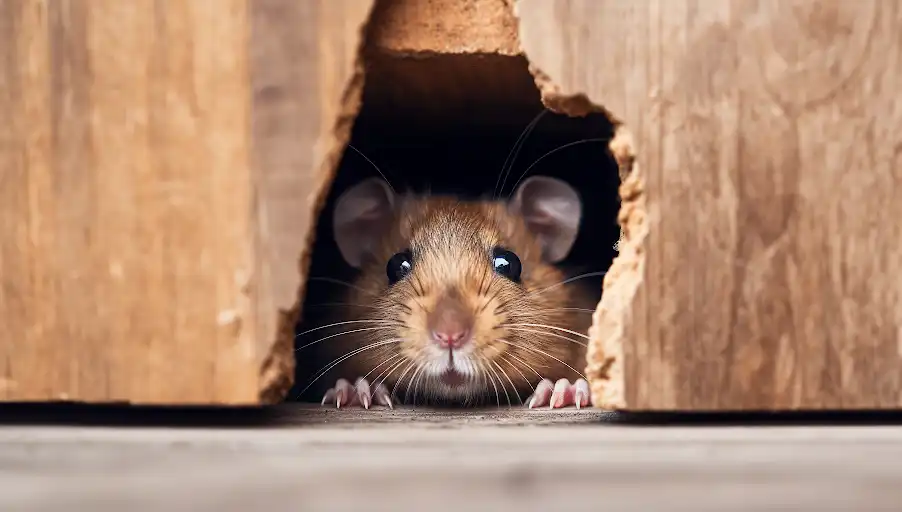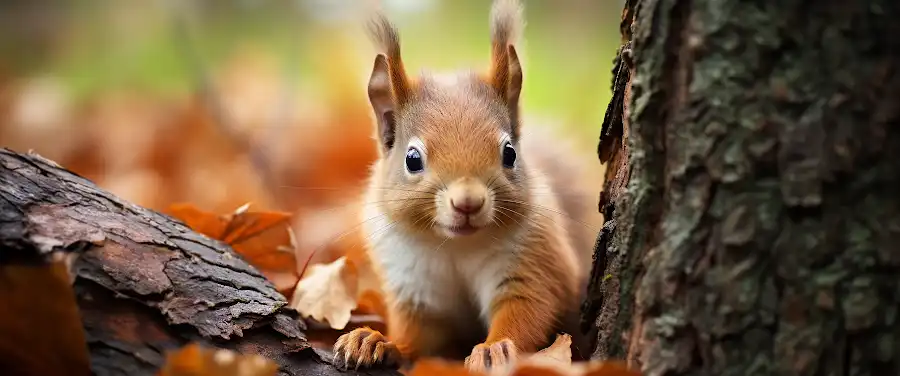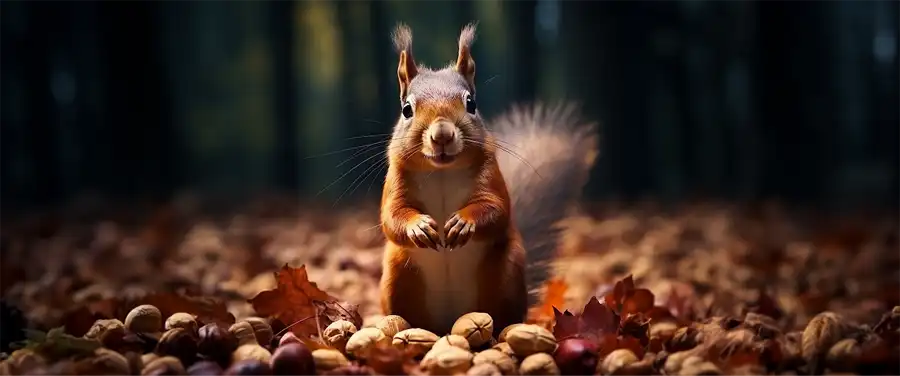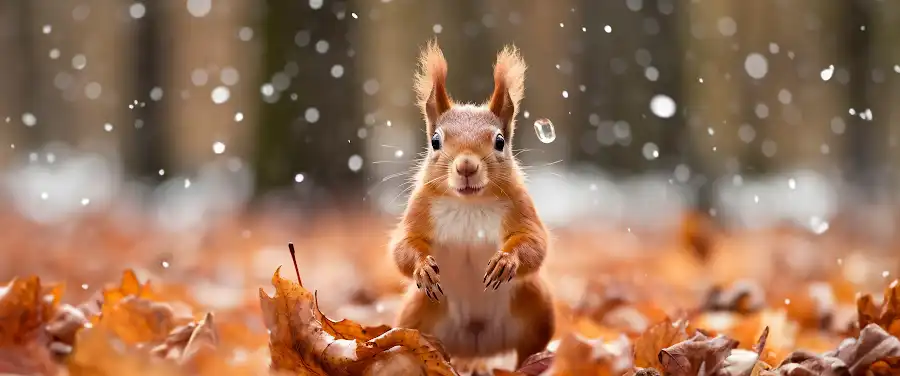
Squirrels. You’ve probably seen them leaping between tree branches, or maybe nimbly navigating power lines like fuzzy tightrope walkers. You might even grumble when they dig up your flower pots or score a free meal from your bird feeder. Whichever way, they’ve been running around your backyard long enough for you to take them for granted. But have you ever stopped to wonder about the fascinating intricacies of their everyday existence?
The simple truth is that squirrels are more than just adorable, nut-burying fluff balls. They are essential to the ecosystems they inhabit, performing key roles like seed dispersion – an ecological service that directly influences the survival and diversity of plant species. From the massive Malabar Giant squirrel of India to the tiny African pygmy squirrel, the world is home to an astounding 285 species of squirrels. Each species presents a unique testament to nature’s boundless creativity and adaptation.
Peeling back the layers of squirrel biology and their life cycles is like stepping into a captivating world that’s all at once familiar, yet brimming with surprises. This tour will take you across the globe, exploring the various ecosystems squirrels contribute to, their diversified species, and the extraordinary particulars of their lifestyles and cycles. It’s time to clamber up the branches of knowledge, join the high-speed chase, and explore the hidden corners of a squirrel’s world! Just imagine, what lies beneath that soft fur and twitchy nose could reveal fundamental clues about our own existence too. Now, let’s embark on this nutty adventure, starting with the basic question – “What are squirrels?”
How are Squirrels Physically Adapted to Their Environment?
What makes squirrels so nimble, quick, and expert at adaptation? It’s all down to their distinctive physical characteristics. The squirrel anatomy is tailored for their survival, skillfully equipped to deal with the challenges of different ecosystems. Central Florida forests, for example, bear witness to these small creatures’ striking adaptability.
A typical squirrel sports a compact body structure with short front legs and longer back ones. Its front paws are adapted for handling food items in that iconic, almost ‘human-like’ pose. Its rear legs are powerful and can propel the creature in impressive leaps during rapid chases or to leap from branch to branch.
Moreover, squirrels also have highly developed sensory organs, which assist them in certain adversities. Their noses are adapted to pick up scent trails while their eyesight is excellent for spotting danger or finding food sources.
The most impressive part of a squirrel’s body is their fur, which changes according to the season. During winter, the fur thickens to provide warmth, and in summer, it thins out to regulate body temperature.
| Characteristic | Description |
|---|---|
| Body Size | Compact, varies by species |
| Front Legs | Short and adapted for handling food |
| Back Legs | Powerful, designed for leaping |
| Senses | Highly developed for survival |
| Fur | Changes according to the season for temperature regulation |
Now, let’s delve a little deeper into how these physical traits assist them in survival.
How Do Squirrels Use Their Tails?
In the realm of squirrel biology, the tail is much more than an aesthetic feature. A squirrel’s tail serves three crucial purposes: balance, signaling, and warmth. In terms of balance, they use their tails as a counterbalance when running along branches or leaping from tree to tree, providing them with a razor-sharp precision.
Signaling is another key function. Squirrels often twitch their tails when something arouses their curiosity or as an alarm signal for potential danger. As for warmth, on freezing days, squirrels can wrap their bushy tails around their bodies like a blanket to insulate themselves from the cold.
What Role Do Squirrels’ Teeth Play?
A squirrel’s dentition is equally instrumental in its survival. Squirrels are equipped with sharp, curved incisors that keep growing throughout their life. This continuous growth counteracts the wear and tear from the constant gnawing of nuts or bark. Additionally, these teeth fill a crucial role in their foraging behavior – enabling them to break open hard-shelled nuts and seeds, thereby extracting the nutritious content inside.
Understanding each aspect of squirrel biology and life cycles contributes to our greater appreciation for these tenacious creatures. Next in our journey of exploration, we will examine the captivating life cycles of squirrels, unveiling their developmental stages and reproductive habits. So, why not hop along for another fascinating leap into the world of squirrels?
How do Squirrels Reproduce, and What is Their Life Cycle?

When it comes to squirrel biology and life cycles, the fascinating journey begins with reproduction. Male squirrels, eager to find their mates, will engage in a lively chase in pursuit of a female in estrus, a period when she is most fertile. This exciting activity may involve several males all pursuing one female, with the fastest and most persistent male earning the breeding rights.
Once successful mating occurs, the female squirrel embarks on a gestation period of about 35 to 60 days, depending on the specific squirrel species. The offspring are born blind, toothless, and hairless, completely dependent on their mother for survival. At this stage, which is fittingly referred to as infancy, the tiny creatures resemble tiny pink erasers.
The next stage, known as the ‘kit’ or ‘pup’ stage, occurs around the sixth week when the babies’ eyes and ears open up, and they begin to grow fur. During the ‘juvenile’ stage, which is around ten to twelve weeks, these little adventurers are already exploring the world outside the nest and have started developing the skills necessary for adult squirrel life.
Finally, they reach the ‘adulthood’ stage at around eight or nine months, where they are fully independent and ready to venture out and continue the cycle of life themselves. Here is a simplified table showing the squirrel’s life stages and their corresponding timeframes:
| Life Stage | Age | Characteristics |
|---|---|---|
| Infancy | Birth-6 weeks | Blind, toothless, and hairless |
| Kit or Pup | 6-10 weeks | Eyes and ears open, fur grows |
| Juvenile | 10-12 weeks | Start exploring outside the nest |
| Adulthood | 8-9 months | Fully grown and independent |
Do Squirrels Exhibit Any Unique Parenting Behaviors?
When it comes to squirrel parenting, female squirrels act as single mothers, the males having no part in the caring of the offspring. The mother’s behavior becomes highly protective and territorial during this period as they focus on providing and safeguarding their young ones. Nests are built high up in the trees to protect the infants from predators.
Another intriguing aspect of the squirrel’s biology and life cycles is their preparation for independent life. While the juvenile squirrels play and explore, they are also learning essential survival skills such as burying nuts for winter, foraging for food, and evading predators. By the time they reach adulthood, they are well-equipped to live independently.
To discover more about squirrels’ biological practices and quirky habits, visit the National Geographic site for a wealth of information.
As we descend deeper into the intriguing world of squirrels, our examination of Squirrel Biology and Life Cycles would be incomplete without understanding the dietary habits of these agile creatures. Imagine a squirrel nibbling on an acorn… but what else does their menu entail? We’ll delve into that in the next topic: ” What are the Dietary Habits of Squirrels?”
What are the Dietary Habits of Squirrels?

When it comes to the culinary preferences of squirrels, these little acrobats of tree-tops in Central Florida have quite the varied diet. Squirrels are omnivorous, which means they can eat a wide range of foodstuffs. They can munch on anything from plant-based food such as fruits, vegetables, nuts, and seeds, to small insects. The diet varies greatly between different species, with some favoring certain nuts or fruits over others.
The diet of a squirrel plays a crucial role in determining its lifespan and overall health. Just as humans need a balanced diet to stay healthy, so do squirrels. Eating a balanced diet full of nutrients can help squirrels live up to their maximum lifespan, which can be up to a whopping 20 years for certain species. It’s not just about quantity, though. Quality food that squirrels eat can also reduce their susceptibility to certain illnesses.
Can Squirrels Eat Human Food?
Squirrels and human menus, can they intermix? There are indeed many types of human food that squirrels can safely consume. Foods such as fruits, vegetables, nuts, and seeds are not only safe for squirrels, but they are also part of their natural diet. These, however, need to be raw and prepared without any seasoning.
Interestingly, certain human foods can be harmful to squirrels and should be avoided. These include processed foods, chocolate, caffeine, alcohol, and anything high in sugar, salt, or artificial flavorings. Moreover, it’s crucial to avoid feeding squirrels any kind of dairy products as they are lactose intolerant and cannot digest them properly.
Living in harmony with these energetic, cute, and bushy-tailed creatures can be a joy. Comprehending the squirrel biology related to their dietary habits enables us to provide them with food that is beneficial to their health while refraining from those harmful.
With the changing seasons, we also observe a shift in the behavior of these creatures. But what exactly triggers these changes? It’s time to dive into our next topic, “How Do Squirrels Behave in Different Seasons?” Let’s find out more about these incredible survival tactics tied deeply into the squirrel’s life cycles.
How Do Squirrels Behave in Different Seasons?

When we think of squirrels, visions of tiny creatures scurrying around looking for food always come to mind. But ever wondered how their activities change with the shifting seasons? Let’s take a deep dive into the squirrel biology and life cycles, particularly how their behavior changes with the seasons.
Understandably, the life of a squirrel isn’t just about frolicking around in the sun. It’s a cycle of preparation, survival, and adaptation that varies with the seasons – be it fierce summers or harsh winters.
Spring
With the arrival of spring, squirrels are typically involved in two primary activities – mating and foraging. This season turns out to be a major feeding period for them. They are seen indulging themselves with buds, flowers, fresh shoots, and insects! It’s also during this period where the young are born and raised.
Summer
As the mercury levels rise, so does the activity level of these furry creatures. Squirrels use this phase efficiently to prepare for their future. They utilize the abundance of nuts, fruits, and seeds in the summer to stockpile their cache for the forthcoming seasons.
Fall
Fall, with its dropping temperatures, is the time for maximum food accumulation. Squirrels usually eat to their heart’s content and stash away the remaining for the challenging times ahead. Their body mass increases as a means to survive in the cold season.
Winter
Installation of insulation with their extra fat credits, squirrels prepare for winter by creating a cozy den. Depending upon the species and location, some squirrels would hibernate, while others will venture out in search of food from their cache when weather conditions are in their favour.
Here’s an elaborate view into this cycle:
| Season | Activity | Food Source |
|---|---|---|
| Spring | Mating & Foraging | Buds & Insects |
| Summer | Food Gathering | Fruits & Seeds |
| Fall | Food Storing | Nuts & Seeds |
| Winter | Hibernation | Stored Food |
Squirrels have proven to be one of the adaptive creatures to their environment, be it blazing summers or the freezing winters. Their survival strategies and behavioural patterns change, essentially maintaining the balance in their ecosystem. Find out more about the secret lives of squirrels here.
Understanding squirrel behaviour during different seasons gives us a wider perspective on their remarkable adaptability and resilience. As we glide from the hustle and bustle in spring to a slow and cozy winter, our backyard friends are also transitioning in their unique ways. Let’s now uncover some unique squirrel species and their special traits.
Conclusion
As we conclude our exploration of squirrel biology and life cycles in Central Florida, it’s clear that these lively, charming creatures lead complex, fascinating lives. Each phase of their life, from birth and youthful exploration to maturity and reproduction, is a testament to their resilience and adaptability.
Squirrels’ biology is a marvel of evolution, allowing them to thrive in a variety of habitats. Likewise, their life cycles, whether they’re hopping about in juvenile diaspora or sitting tight in adult territoriality, reflect their diversity and engrossing lifestyles.
Engaging your interest in squirrel biology and life cycles not only heightens your knowledge of the natural world but also increases your appreciation for wildlife in your own backyard.
Going forward, don’t just narrowly watch squirrels as they scamper about. Instead, take time to observe them. Learn about their distinctive behaviors and roles in our ecosystem. Remember, every creature, no matter how small or commonplace, holds a complex secret lifestyle.
By understanding and appreciating these captivating creatures, we can help to preserve their habitats and ensure the continuity of their species. Let’s remember to coexist harmoniously with nature, ensuring these little critters continue to grace our lives with their acrobatic antics and bushy tails.
This is your cue to delve deeper and explore the unique world of squirrels. So, are you ready to uncover more about these fascinating friends in our backyards? Let’s keep learning, observing, and appreciating our furry friends!
Article recap:
- Squirrels’ biology is a marvel of evolution
- Squirrels go through various stages in their life cycles
- Squirrels have complex lifestyles
- Understanding and appreciating squirrels can help their preservation
Squirrel appreciation is not just about finding them cute or amusing. It’s about acknowledging their intricate role in the ecosystem and their resilience in the face of constant change. With increased knowledge and understanding, we can ensure the survival and thriving of these amazing beings for generations to come. So, next time you see a squirrel scurrying about, remember, you’re witnessing a small slice of wildlife’s great wonder!
Let’s delve more into the secret life of squirrels. They’re much more than just bushy tails and acrobatic antics. They are living, breathing bundles of evolution’s grandeur. So, let’s admire them for what they truly are – complex creatures with unique roles in this grand scheme of life.




